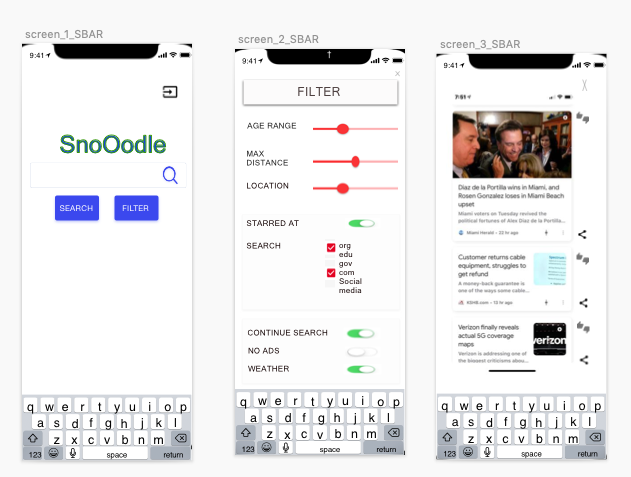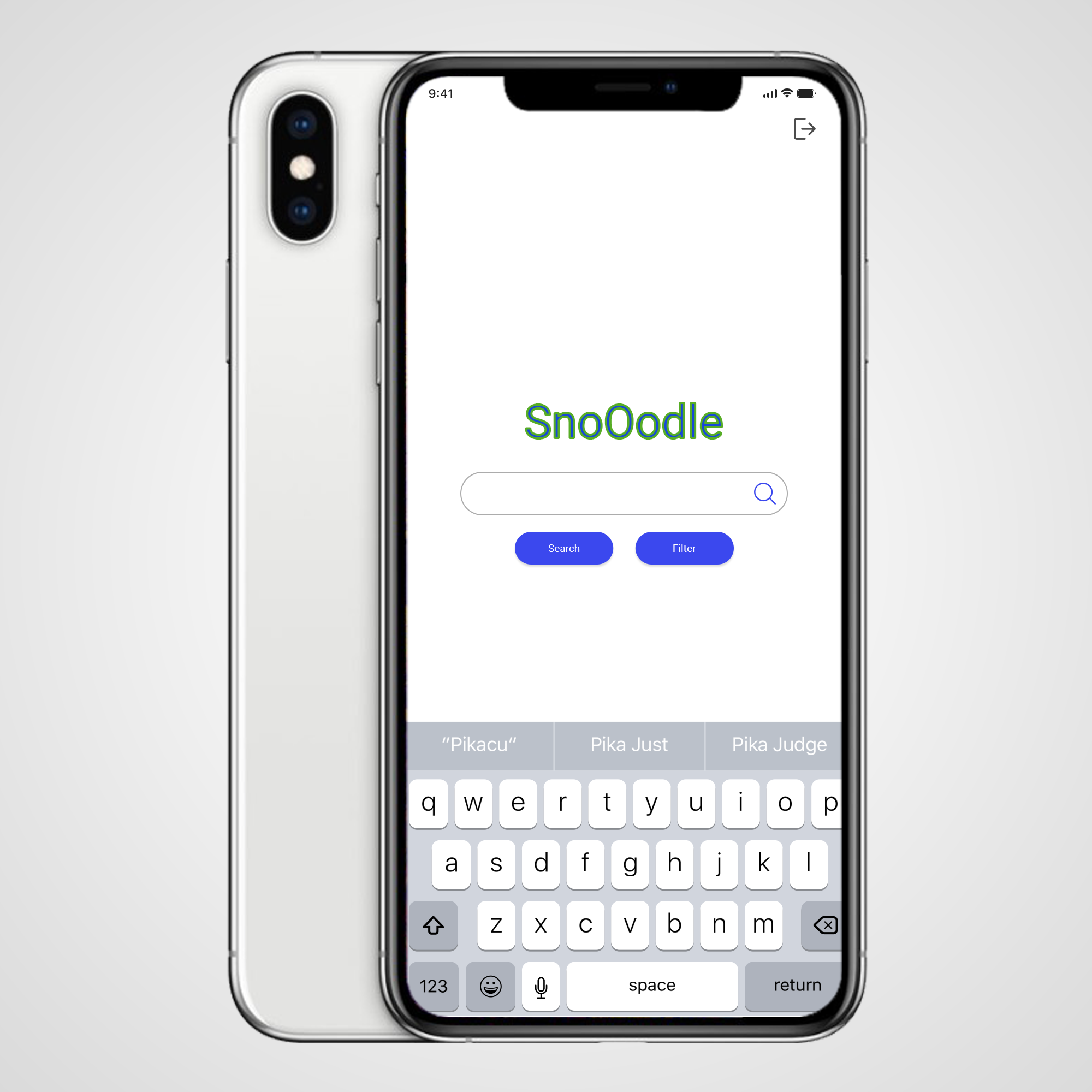Problem
How can we create a more efficient way for searching for specific data on the web. I found that the search results space is too commercial and filled with ads and all the power placed in search engine algorithm, where the results are not always specific to the users needs. How can we get true organic search? How can we get search results specific to the user? Built around the user specific individual preference.
Competitive Analysis
Competitive Research, was used to uncover the strengths and weaknesses of other products. This type of research includes Norman & Nielsen rules of thumb for good interaction design which will help spot weaknesses and potentially identify the areas where new thinking and designs need to be formed. Here is what I discovered:-
Being competitive in an already crowded market with big players like Google , Bing and yahoo. My approach was to remain focused on what was missing from the already existing apps and to overlap their features. I continued the discovery phase with a usability heuristic analysis. I used Norman & Nielsen rules of thumb for good interaction design to learn more about competitors and understand where their strengths and weaknesses were to create a product more centered around the Human Centered design.
My Research Approach
My research approach was to use a variety of research methods to gain a deeper understanding of the problem I faced while working through the different design process.
I used generative research, which will help you to define your problem and generate ideas. Then secondary Research, which involves exploring existing data that relates to your product. I found the following quite interesting:-
My starting point to find a solution for this problem was to try and learn about the habits of people searching on the web for information, what are the different aspects and what is trending. By doing secondary research this what, I learnt ; Ad business a boom for Amazon, but a turn-off for shoppers Mike Maddaloni went to amazon.com knowing exactly what he wanted to buy. But instead of showing him the Synology router he was searching for at the top of the results, Amazon bombarded him with adds for hard drives and routers that he didn’t want. Maddaloni, a web strategist in Appleton, Wisconsin, said searching of the worlds shopping site had always a good experience for him, until a month ago, when he started seeing more ads. Amazon has turned its online store into an advertising powerhouse in just a few years, it overtook microsoft last year as the third largest ad platform, in the United States following Google and facebook. According to the market research firm eMarketer. That’s mostly due to Amazon’s search bar: Most shoppers now go to Amazon, first instead of Google to look up products according to Jumpshot, which tracks online shopping behavior. The downside to Amazon booming ad business is the impact on the user experience . Companies and brands can bid to get their products in Amazon's search listings, sometimes pushing down what shoppers are really searching for and making them harder to find. It risks betraying Amazon’s customer friendly reputation and irritating shoppers like Maddaloni, who are used to Amazon being the place they go to find what they want to buy quickly. Jason Goldberg, a retail Consultant and chief commerce strategy officer at Publicis Communications, said showing ads instead of what people search for is “the best example of Amazon failing to live up to its Mission of becoming earth's most customer centric company. “That's clearly not in the shoppers best interest,” he said. The company said its sponsored ads are a way for Customers to find products they may be interested in. And it uses Machine-learning technology to try and show ads that are relevant to shoppers BUT THAT DOES NOT ALWAYS HAPPEN. A perfect example is :-
After David Sinclair’s book on aging went on sale in September, colleagues told him that when they typed his name on Amazon, they saw ads for vitamins and supplements above his book. The supplement makers had selected Sinclair’s name as a keyword, hoping to get the attention of people who wanted to buy his book, “Lifespan: Why We Age — and Why We Don’t Have To.”
He tweeted a warning to his followers: “If you search for me on Amazon right now, you may first have to scroll past some sponsored ads for supplements. This is not my doing. I do not endorse products.”
The Harvard Medical School professor said the supplement ads made it look like he was somehow linked to the pills, which he is not
“That’s my reputation at stake,” Mr. Sinclair said.
After The Associated Press asked about the vitamin ads, Amazon said it wasn’t a good customer experience and removed them. Credits AP
What I Discovered
At first, I did not have a clear understanding of user goals and what motivates them. After using the various usability techniques. I designed the app around the user experience and from the insights of user personas. While doing this test, I found out that many college students were having a pain point with the current search platforms. What they told me was for a research paper to be credible they would need secondary research papers from org, edu and gov. The snooodle search app, would provide a simple way to gather source information for their research papers and in addition, the search app would keep searching for more and current information, even after the initial search to add more credibility to their school work at college. The Snooodle app, is now designed to enhance people’s lives, and make the search experience more customized for the user, centered around the user experience.

Who am I designing for ?
I conducted several techniques to better understand the objective of the product, the details of the product, the problem it solves and finally, the users. ... From the UX perspective, the discovery process has three different processes: ideas, planification and analysis. This is where the part of the project where I get to learn all about the product and the potential users.The discovery part of the design process is the MOST essential component.
Based on the data I collected, I created representations of one user persona type. The persona did not depict specific people but combined a number of versions, of the persons studied and interviewed, during the user research interviews.
MEET THE USER PERSONA FOR THE SNOOODLE APP

Ideation
At this stage, is all about generating and the formulation of concepts and ideas. To find a solution to the problem from the research data. This is the stage that welcomes letting your imagination soar, as I thought outside of the box. I was able to look at the problem from a variety of angles and came up with cutting edge solutions and designs.
Wireframing
Once I created sketches of the product, the next step is to create wireframes.


Wireframes are digitized versions of my sketches. Creating a low fidelity digital version of my product will enable me to ideate critical design decisions that, I will need to make, while still offering enough flexibility. While, I formulate the concept during the start of the design process.

Usability Testing
The method, I used to get initial feedback on designs, I made was to do guerilla testing; It’s a quick, cost-effective way to learn what users like about my designs and what aspects of my design are a bit less intuitive. This is a chance for me to go out in the field and see if users are able to use my design, and see what interactions are needed and taken away.
When conducting guerilla usability testing, I asked random people at the mall to test my prototype on a sketch cloud on my iphone x. I learnt a lot about the pain points of my design, along with the need to adjust certain aspects of my initial design to be more interactive.
After, I designed the first prototype in sketch, that designed changed many times to the final design, centered on the user experience, during multiple usability testing sessions. Users were tested using the prototype animated in invision on the iphone platform, for pain points and unaccomplished tasks, users were observed and interviewed using the following usability script:-
“Hey thank you for taking some time to assist me with this project. Here is a prototype of an app I developed, I would like to test the prototype with you, and it won’t take too much of your time. I just want to learn if the app will enhance people’s lives and work as intended. I will ask you to complete a couple tasks and that will be all. “
The data from the usability session was gathered on the usability session notes.

Prototyping
The Initial design before the user testing sessions, which I prototyped in sketch and also invision.

How the design changed after usability testing.

Implementation
How the design changed after usability testing sessions and user research, habits and motivation to produce the final high fidelity product centered around the user experience.



Validation
Design thinking is a human-centered approach to innovation that draws from the UX designer’s skills to better the tasks and to streamline the needs of people, the possibilities of customized applications, and the requirements for business success as a whole. While business may be a great success in regards to profits. We should always remember that the user centered experience, should be always at the forefront of all final designs. To remain sustainable and to constantly stay relevant with your user base, in the not so distant future.
Test
I am passionate about, the ability to get insights from observations on how the target Users in the field; engage with the final product, to know and understand their behaviors and usage patterns. This data is used to constantly improve the user experience of the product. One can truly see, such a research process is invaluable, as this would guide and ideate future revisions of the application in order to make it more engaging.
Final thoughts
Building empathy is essential in understanding the needs of the products centered around the user experience. While there needs to be a balance between Stake-holders demands and Engineers pushback, as a UX Designer. One has always to stay focused on the design of the product centered truly around the human-centred design through all stages of the design process. The design should be based solely from user research data and focused on that path until the final production of the product.